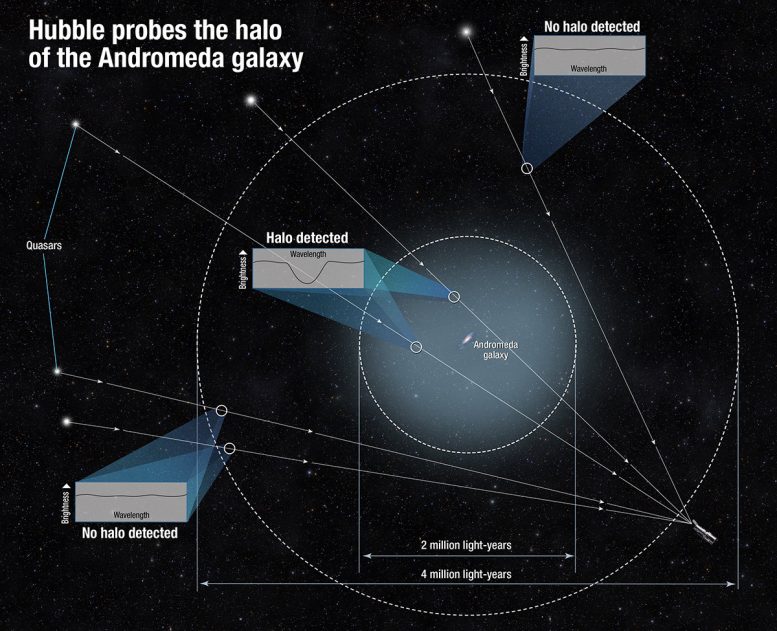
The Andromeda galaxy, our nearest massive galactic neighbor, is about six times larger and 1,000 times more massive than previously measured. Credit: NASA/STScI
Using the Hubble Space Telescope, astronomers have discovered that the immense halo of gas enveloping the Andromeda galaxy is about six times larger and 1,000 times more massive than previously thought.
The dark, nearly invisible halo stretches about a million light-years from its host galaxy, halfway to our own Milky Way galaxy. This finding promises to tell astronomers more about the evolution and structure of majestic giant spirals, one of the most common types of galaxies in the universe.
“Halos are the gaseous atmospheres of galaxies. The properties of these gaseous halos control the rate at which stars form in galaxies according to models of galaxy formation,” explained the lead investigator Nicolas Lehner of the University of Notre Dame, Indiana. The gargantuan halo is estimated to contain half the mass of the stars in the Andromeda galaxy itself, in the form of a hot, diffuse gas. If it could be viewed with the naked eye, the halo would be 100 times the diameter of the full moon in the sky. This is equivalent to the patch of sky covered by two basketballs held at arm’s length.
The Andromeda galaxy lies 2.5 million light-years away and looks like a faint spindle, about 6 times the diameter of the full moon. It is considered a near-twin to the Milky Way galaxy.
Because the gas in Andromeda’s halo is dark, the team looked at bright background objects through the gas and observed how the light changed. This is a bit like looking at a glowing light at the bottom of a pool at night. The ideal background “lights” for such a study are quasars, which are very distant bright cores of active galaxies powered by black holes. The team used 18 quasars residing far behind Andromeda to probe how material is distributed well beyond the visible disk of the galaxy. Their findings were published in the May 4, 2015 edition of the Astrophysical Journal.
Earlier research from Hubble Cosmic Origins Spectrograph (COS)-Halos program studied 44 distant galaxies and found halos like Andromeda’s, but never before has such a massive halo been seen in a neighboring galaxy. Because the previously studied galaxies were much farther away, they appeared much smaller in the sky. Only one quasar could be detected behind each faraway galaxy, providing only one light anchor point to map their halo size and structure. With its close proximity to Earth and its correspondingly large footprint on the sky, Andromeda provides a far more extensive sampling of a lot of background quasars.
“As the light from the quasars travels toward Hubble, the halo’s gas will absorb some of that light and make the quasar appear a little darker in just a very small wavelength range,” explains co-investigator J. Christopher Howk, also of Notre Dame. “By measuring the dip in brightness in that range, we can tell how much gas there is between us and that quasar.”
The scientists used Hubble’s unique capability to study the ultraviolet light from the quasars. Ultraviolet light is absorbed by Earth’s atmosphere, which makes it difficult to observe with a ground-based telescope. The team drew from about 5 years’ worth of observations stored in the Hubble data archive to conduct this research. Many previous Hubble campaigns have used quasars to study gas much farther away than — but in the general direction of — Andromeda, so a treasure trove of data already existed.
But where did the giant halo come from? Large-scale simulations of galaxies suggest that the halo formed at the same time as the rest of Andromeda. The team also determined that it is enriched in elements much heavier than hydrogen and helium, and the only way to get these heavy elements is from exploding stars called supernovae. The supernovae erupt in Andromeda’s star-filled disk and violently blow these heavier elements far out into space. Over Andromeda’s lifetime, nearly half of all the heavy elements made by its stars have been expelled far beyond the galaxy’s 200,000 light-year diameter stellar disk.
What does this mean for our own galaxy? Because we live inside the Milky Way, scientists cannot determine whether or not such an equally massive and extended halo exists around our galaxy. It’s a case of not being able to see the forest for the trees. If the Milky Way does possess a similarly huge halo, the two galaxies’ halos may be nearly touching already and quiescently merging long before the two massive galaxies collide. Hubble observations indicate that the Andromeda and Milky Way galaxies will merge to form a giant elliptical galaxy beginning about 4 billion years from now.
The Hubble Space Telescope is a project of international cooperation between NASA and the European Space Agency. NASA’s Goddard Space Flight Center in Greenbelt, Maryland, manages the telescope. The Space Telescope Science Institute (STScI) in Baltimore conducts Hubble science operations. STScI is operated for NASA by the Association of Universities for Research in Astronomy, Inc., in Washington.
Reference: “Evidence for a Massive, Extended Circumgalactic Medium Around the Andromeda Galaxy” by Nicolas Lehner, Chris Howk and Bart Wakker, 4 May 2015, The Astrophysical Journal.
DOI: 10.1088/0004-637X/804/2/79
arXiv: 1404.6540



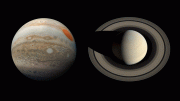

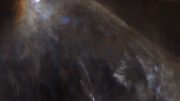

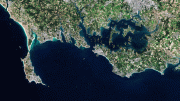
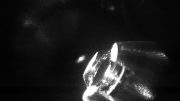
Welp, the necessity for the existence of Dark Matter just took another huge hit . . .
Interesting.
How does this compare to the expected amount of dark matter around Andromeda? I never like some of the explanations for dark matter as it makes more sense to me that we simply can’t see all of the conventional matter. Hopefully this study will get much needed exposure.
I’ve always seen it just as you. I can’t understand why they want to try to invent some new kind of matter to explain the situation, when we’ve always known it’s dark out there. It’s not at all surprising that we can only see so much of all that’s out there.
Dark matter? This imaginary concept has yet to be observed or experimentally confirmed. Using it to explain current observations seems to be unsound from a scientific basis. Using one unproven theory to explain another unproven theory essentially builds a house of cards. This is the reason cosmology is in the predicament it is in today. As new observations are made, more and more contradictions and questions arise.
Why not try a different approach? For example, we know that massive magnetic fields are present at the galactic level. We know that electromagnetic forces are extremely powerful. Under the right conditions in the laboratory, plasma, magnetic fields and electric current induce spiral galaxy formation ( and these galaxies have the correct velocities as well). These “clouds of hot gasses” (plasma) seem to be contained by magnetic fields and have a noticeably symmetric appearance.
It is time to start using known laws of physics and sound scientific principles while interpreting new data/observations. Reliance on concepts which have never been proven creates science fiction, not science.